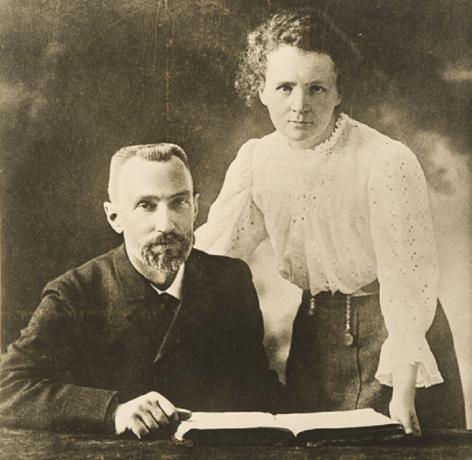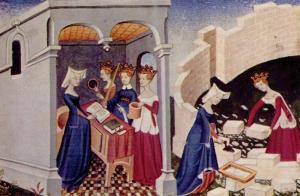Marie Curie: biography of this pioneering radioactivity researcher
It is impossible to train in the field of both Physics and Chemistry science and not know Marie Curie.
This researcher was one of the best known scientists, standing out above all in the study of radioactivity. Together with her husband Piere, she made important discoveries such as the elements radium and polonium.
Her works were recognized by awarding her two Nobel prizes both in the field of Physics and Chemistry, and her contributions did not remain only in these her two camps, since during the First World War she collaborated with doctors and nurses for a better recovery of the soldiers, using mobile units of X-rays.
In this article we will mention the most important events in the life of this scientist through a biography of Marie Curie.
- Related article: "The 12 branches (or fields) of Psychology"
Short biography of Marie Curie
Maria Salomea Sklodowska, better known by the name of Marie Currie, was born on November 7, 1867 in the city of Warsaw, Poland. Both of her parents were teachers, her father was a Physics and Mathematics teacher and her mother a piano and singing teacher. She was the youngest of five children and she did not have a wealthy childhood as her parents had lost all her property.
At that time the Russians had occupied Poland, thus losing part of the teaching of the Polish language and culture. For this reason she Marie herself attended clandestine classes to learn the customs of the country.
The Russian rule in Poland also hurt the work of Marie's father, who lost his job for being a sympathizer of Polish culture. Similarly, when laboratory teaching was forbidden in schools, her father brought all science material to her home and used it to teach her children the usefulness of it.
Marie Curie's life was also marked by the premature death of one of her sisters and her mother, events that caused Curie to lose her Catholic faith.
- You may be interested in: "The 9 postulates of Dalton's atomic theory"
Youth and college years
As for her educational career, Curie entered the boarding school of J. She sikorska, to be later transferred to an institute for girls, graduating in 1883 with a gold medal. Due to the difficulties women had in those days to be educated, she had to enroll with her sister in a clandestine Polish university that admitted women.
In order to get money to pay for her sister Bronislawa's medical studies and hers for her own studies, she worked as a private teacher and as a governess. Her sister moved to Paris in 1890 and proposed to Marie that she go with her and her husband, but this she did not accept, as she had not yet raised enough money to pay for college tuition.
Even so she never stopped studying and training, she continued to attend the clandestine university and she began the study of it in the field of practical science by attending the chemical laboratory of the Museum of Industry and Agriculture.
A year later, at the age of 24, she was finally able to move to Paris with enough money, which she had saved thanks to her work and the help of her father, to continue her training. Already in the new city she continued with her studies in Physics, Chemistry and Mathematics at the University of Paris the SorbonneShe, who despite her good level in these matters, had to make an effort to learn and understand French.
In Paris her living condition did not improve, since to pay for her housing and studies, she had to work teaching at night. But her efforts were successful, and in 1893 she was able to graduate in Physics, she being the first of her in promoting it and thus being able to start working in an industrial laboratory. Her studies in the field of Physics did not cease, and in 1894 she obtained the second degree at the already named University of Paris. She also had as a hobby the theater acting in some plays.
- Related article: "The 26 best famous phrases of Marie Curie"
Her professional life in research
In 1894 he made one of his first investigations by the Society for the Promotion of National Industry, with the purpose of study and know the magnetic properties of various steels.
It was in this year when she met who would be her future husband, Pierre Curie, at first her union was only professional since Pierre, who He was an instructor at the École Supérieure de Physique et des Chemie Industrial de Paris, he provided Marie with a laboratory with a larger space to to work. But his great interest and passion for science formed a closer bond between them, thus marrying on July 26, 1895.
She continued her training by performing her doctorate, whose thesis focused on research on radioactive substances. She chose this topic given the discoveries made by Henri Becquerel of uranium radiation and Wilhelm Röntgen of X-rays.
By conducting research she can disprove previously accepted hypotheses such as the one that atoms were indivisible. Neither she nor her husband knew of the danger of working with the establishment without controlling the conditions, at that time the associated diseases that it entailed were not yet known.
On a personal level, Marie and Pierre had their first daughter named Irène in 1897Thus, given her new incorporation into her family, Marie decided to combine her research with her work as a teacher at the École Normale Supérieure in Paris and thus be able to support her daughter.

- You may be interested in: "The 5 ages of History (and their characteristics)"
Consolidation of her career as a scientist
The couple continued with their research in the field of radioactivity and it will be in 1898 when they made public the discovery of two new radioactive elements: polonium and radium that showed more radioactivity than the already known uranium. Despite their announcement, it took them four more years to prove their discovery.
In her work as a teacher, Marie Curie she was the first woman to be appointed a professor at the Higher School where she taught in 1900. The continuous contact of her with radiation caused that in 1903 she and her husband had the first symptoms and health problems.
Piere and Marie made multiple joint publications where they came to affirm that if the cancer cells that formed tumors in radium, these were destroyed faster than cells healthy.
It was in 1903 when she got the first accolades of her receiving the Davy Medal from the Royal Society of London for her discovery in the field of Chemistry and the precious Nobel Prize in Physics awarded, together with her marriage, also to Henri Becquerel for his research on radioactivity. She was thus the first woman to receive this award, although it was not an easy task since at first it was intended to give recognition only to the two men.
A year later, in 1904, her second and last daughter, Ève, was born. The health of the marriage continued to deteriorate due to constant radiation exposures. It was in 1906 when an accident ended the life of Pierre, causing this catastrophic event that she suffered Marie depression. On May 13 of that same year, she became Professor of Physics at the University of Paris, before she belonged to her husband, she being the first woman to teach at this university.
Marie Curie was a member of the Swedish, Czech and Polish Academy of Sciences, but not she managed to join the French Academy of Sciences, receiving multiple criticisms for being a woman and foreign. These criticisms did not cease, since in 1911 the romance that she had had with a former student of her husband's husband came to light, thus blaming her, in a bad way, for being a home breaker.
But the investigations and recognitions of her did not stop, awarding him in 1911 the Nobel Prize in Chemistry for her discoveries of radium and polonium, the isolation of radium and the study of the nature of this element.
Despite her recognition and her awards, her psychological and physical problems were on the rise, thus deciding that the best option would be to take time off. A year later, in 1913, she improved her state of health, thus allowing her to study the properties of radium radiation at low temperatures.
- Related article: "Scientific Revolution: what is it and what historical changes did it bring?"
The Great War and postwar years
Her research and studies were interrupted by the First World War, but Marie's contributions did not cease, she proposed the creation of mobile radiography units, X-ray equipment, in order to better attend to the wounded soldiers and held the position of director of the Radiology Service of the Red Cross French.
After the war, Marie traveled to the United States to raise funds and thus continue with the radio investigation. In 1920 she founded the Curie Institute, which today is one of the leading centers for medical, biological and biophysical research.
Last years and death
In 1922 she was a member of the International Commission for Intellectual Cooperation of the United Nations League she and she member of the National Academy of Medicine of France. She was also a member of the International Committee for Atomic Weights of the International Union of Chemistry.
Marie Curie died on July 4, 1934 in the sanctuary of Sancellemoz, in France, due to aplastic anemia. Her research on radioactivity and unprotected X-ray exposure seriously harmed her health.

